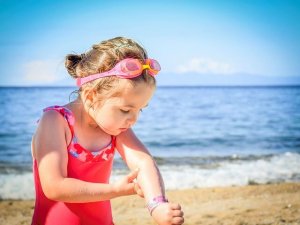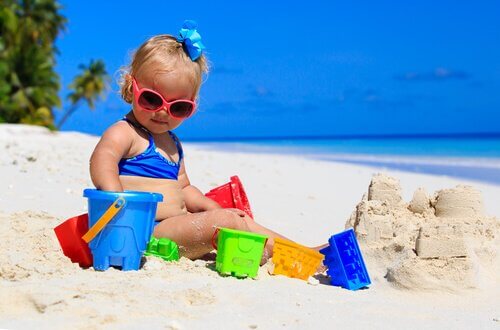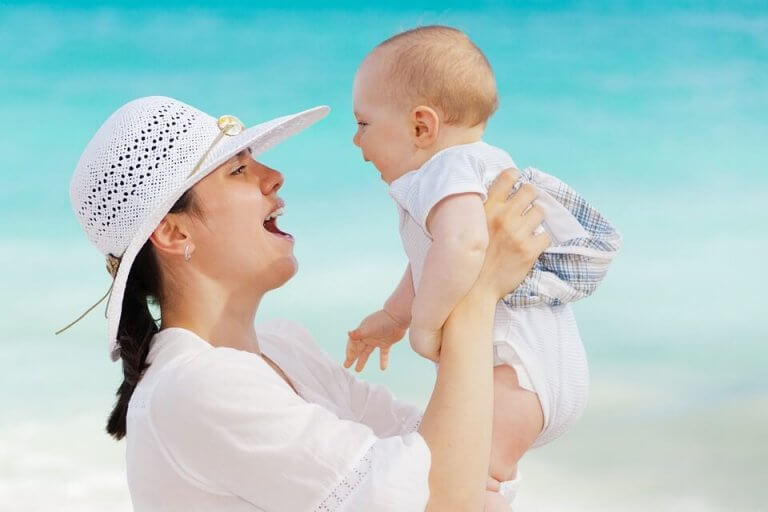Babies and Children: When to Start Using Sunscreen

In summer and during other times of year, the sun can be very harmful to the skin of adults and children alike. But when should little ones start using sunscreen?
Outdoor activities with kids are an excellent option for parents and children to spend time together. However, there are certain precautions to keep in mind. These include, of course, those related to weather.
Logically, the basic preventative measure is to avoid sun exposure, above all during hours when the sun is most intense. Additionally, wear light clothing so your skin isn’t directly exposed to sunlight. It’s also a good idea to keep your head covered.
Using sunscreen appropriate for your child’s age is also recommended. Parents often have questions about this. When should you start using sunscreen on your baby?
At What Age Should You Start Using Sunscreen?
We mentioned above that there are times when you should avoid sun exposure. For adults, the highest risk is between 12:00 pm and 4:00 pm. However, for babies under 6 months, this can be extended by one hour on either side.
For babies who are in this age, there is a fundamental aspect of sunscreen you should consider: its composition. There are some that have what’s known as a “chemical filter,” which are what we usually use as adults.
Due to the ingredients, chemical filter sunscreens aren’t recommended for babies’ delicate skin. It can cause allergic reactions or irritation.
On the other hand, “physical filter” sunscreens are okay to use on babies. The difference is that these aren’t absorbed into the skin, meaning there is a lower probability of causing skin problems.
The white color, though it might annoy kids, is an indicator. When it disappears it means it’s time to reapply the sunscreen.
In any case, we recommend using this sunscreen when there isn’t another alternative. If you can avoid sun exposure it’s always the better option. With this simple but vital preventative measure, you’ll avoid all kinds of problems, from sunburn to heat stroke.

Sunscreens for Babies over 6 Months
Although there are products on the market to use as sunscreen for babies over six months old, it’s also not the best choice. The presence of substances like parabens can be counterproductive for the health of children, as can fragrances.
On the other hand, there are sunscreens that have ingredients like omega 3. Other substances that have positive effects are zinc oxide and titanium, above all for sensitive areas like the face and ears.
When trying to protect their children as much as possible, mothers tend to smear their kids with these products. The result, far from better protection, is actually the opposite because it will result in more absorption of potentially harmful substances.
“The basic preventative elements are avoiding sun exposure, above all when the sun is most intense.”
After Age 3 It’s Safe to Use Sunscreen
The majority of sunscreen – except when the manufacturer indicates otherwise – are appropriate for kids older than 3. At this age, their skin is more able to resist and is more prepared to handle these substances, as well as to protect against ultraviolet rays.
At this age, children can move around on their own. Consequently it’s much more difficult to keep them still and protected from the sun.
Using sunscreen then becomes indispensable for good health care. However, the recommendations around what hours are most dangerous remain the same.

Advice for Using Sunscreen
If your you’re going to start using sunscreen with your child, the following suggestions can be helpful:
- Apply only one layer, above all on the arms, feet, and face. If they aren’t fully dressed – for example on the beach or at the pool – put it on your body as well.
- Use it 30 minutes before your child will be exposed to the sun.
- Reapply after each swim. Most sunscreen dilutes in water.
- Reapply after 2 hours, even if the child hasn’t been in the water.
As for the strength, it’s not always best to use the maximum, 50. If you’ve been to the pediatrician and they gave you a recommendation, follow them.
Keep in mind that kids are more exposed to factors like the sun, cold, and heat than adults are. Taking precautions, like starting to use sunscreen, cannot be emphasized enough, as long as your child is the right age for the product you use.
In summer and during other times of year, the sun can be very harmful to the skin of adults and children alike. But when should little ones start using sunscreen?
Outdoor activities with kids are an excellent option for parents and children to spend time together. However, there are certain precautions to keep in mind. These include, of course, those related to weather.
Logically, the basic preventative measure is to avoid sun exposure, above all during hours when the sun is most intense. Additionally, wear light clothing so your skin isn’t directly exposed to sunlight. It’s also a good idea to keep your head covered.
Using sunscreen appropriate for your child’s age is also recommended. Parents often have questions about this. When should you start using sunscreen on your baby?
At What Age Should You Start Using Sunscreen?
We mentioned above that there are times when you should avoid sun exposure. For adults, the highest risk is between 12:00 pm and 4:00 pm. However, for babies under 6 months, this can be extended by one hour on either side.
For babies who are in this age, there is a fundamental aspect of sunscreen you should consider: its composition. There are some that have what’s known as a “chemical filter,” which are what we usually use as adults.
Due to the ingredients, chemical filter sunscreens aren’t recommended for babies’ delicate skin. It can cause allergic reactions or irritation.
On the other hand, “physical filter” sunscreens are okay to use on babies. The difference is that these aren’t absorbed into the skin, meaning there is a lower probability of causing skin problems.
The white color, though it might annoy kids, is an indicator. When it disappears it means it’s time to reapply the sunscreen.
In any case, we recommend using this sunscreen when there isn’t another alternative. If you can avoid sun exposure it’s always the better option. With this simple but vital preventative measure, you’ll avoid all kinds of problems, from sunburn to heat stroke.

Sunscreens for Babies over 6 Months
Although there are products on the market to use as sunscreen for babies over six months old, it’s also not the best choice. The presence of substances like parabens can be counterproductive for the health of children, as can fragrances.
On the other hand, there are sunscreens that have ingredients like omega 3. Other substances that have positive effects are zinc oxide and titanium, above all for sensitive areas like the face and ears.
When trying to protect their children as much as possible, mothers tend to smear their kids with these products. The result, far from better protection, is actually the opposite because it will result in more absorption of potentially harmful substances.
“The basic preventative elements are avoiding sun exposure, above all when the sun is most intense.”
After Age 3 It’s Safe to Use Sunscreen
The majority of sunscreen – except when the manufacturer indicates otherwise – are appropriate for kids older than 3. At this age, their skin is more able to resist and is more prepared to handle these substances, as well as to protect against ultraviolet rays.
At this age, children can move around on their own. Consequently it’s much more difficult to keep them still and protected from the sun.
Using sunscreen then becomes indispensable for good health care. However, the recommendations around what hours are most dangerous remain the same.

Advice for Using Sunscreen
If your you’re going to start using sunscreen with your child, the following suggestions can be helpful:
- Apply only one layer, above all on the arms, feet, and face. If they aren’t fully dressed – for example on the beach or at the pool – put it on your body as well.
- Use it 30 minutes before your child will be exposed to the sun.
- Reapply after each swim. Most sunscreen dilutes in water.
- Reapply after 2 hours, even if the child hasn’t been in the water.
As for the strength, it’s not always best to use the maximum, 50. If you’ve been to the pediatrician and they gave you a recommendation, follow them.
Keep in mind that kids are more exposed to factors like the sun, cold, and heat than adults are. Taking precautions, like starting to use sunscreen, cannot be emphasized enough, as long as your child is the right age for the product you use.
All cited sources were thoroughly reviewed by our team to ensure their quality, reliability, currency, and validity. The bibliography of this article was considered reliable and of academic or scientific accuracy.
- González, G. (2016). Sol ¿enemigo o aliado de la piel del bebé? en: https://eresmama.com/sol-enemigo-o-aliado-de-la-piel-del-bebe/
- Food and Drug Administration. FDA. en: https://www.fda.gov/consumers/articulos-en-espanol/debe-ponerles-protector-solar-los-bebes-por-lo-general-no
- Paula Luna. (2014). Congresos Sociedad Argentina de Pediatría.
This text is provided for informational purposes only and does not replace consultation with a professional. If in doubt, consult your specialist.








